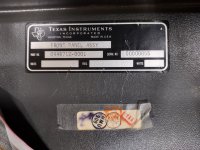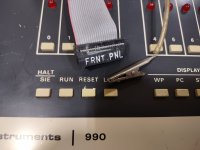The DX10 and DNOS System Design documents on bitsavers describe the contents and directory structures of the corresponding source disks. Comparing this info with available tape and disk images is in order.
Appendix B,
http://bitsavers.org/pdf/ti/990/dx10/0939153-9701C_3.4_SystemDesignDocument_Oct81.pdf
Section 21,
http://bitsavers.org/pdf/ti/990/dnos/2270512B_DNOS_System_Design_Document_Nov83.pdf
Somewhere on my daily driver desktop that is down for the count with a flaky mb atm, there is some document that describes the DX10 source distribution kit. IIRC, the sources were distributed on something like a DS25 or DS31 disk pack, or larger. Probably on 1/2" tape as well, but don't hold me to that. The source kit included listings on microfiche as well, I believe. I will try to dig reference out though, and get PNs for the source kits and contents if I can. I'm thinking it was a price list of some sort. These numbers, though, will also be referenced in the documents
@FarmerPotato listed above.
Here is our problem: Any distribution media seems lost to time. The source kits don't seem to have been widely distributed outside of TI, and media doesn't seem to have been a priority, or even on the radar, for archivists, very unfortunately. It would be good for someone to triple-check the SMU archive just to be sure. Possibly one of the 990 OEMs like Timberline or Moore Business Systems would have gotten source kits, or possibly one of the companies which bought TI divisions with 990 relevance, but at this point anything 990 from those sources is likely only going to be found at estate sales, something someone took home with them as it was headed out the door to the dumpster, or from an employee sale of obsolete items from an upgrade, etc.
Which brings me to my point, I apologize if this is a horse I have beat to death elsewhere, but the 990/12 in the possesion of the Centre for Computing History in Cambridge, UK came from a development lab at TI Bedford. Most 990's were sold for production use. 990s had nowhere near the penetration in academic environments that DEC equipment did. What 990s TI did sell, for instance to the Georgia University System, was primarily, if not exclusively, used in business and administration departments, and my searching over the years indicates most machines were scrapped, documents pulped, and media recycled. The Blanden machine at the museum in Cambridge came out of a development environment, though, and possibly includes the sources for one or more operating system on disk or tape. Really, really needs to be checked out.
Other than that, our best hope is that one of the other computer museums has something lurking in a back room or warehouse that hasn't been cataloged and/or imaged yet. And if anyone here has anything they could share, that would be great, too.



